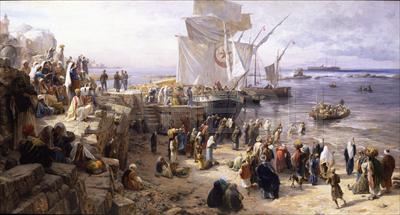Gustav Bauernfeind (German, 1848–1904)
Jaffa, Recruiting of Turkish Soldiers in Palestine, 1888
Oil on canvas, 58 1/2 x 110 1/4 in.
Signed, dated, and inscribed lower left: G. Bauernfeind / Munich 1888 / Jaffa Palästina
1999.4
Initial conservation and framing of this painting generously provided by Richard Green Gallery, London

This painting, which addresses issues of class and religion in the late Ottoman Empire, is the masterwork of this German artist who devoted himself to Orientalist themes. Bauernfeind began his first journey to the Middle East in 1880, after learning about the region from his brother-in-law, a missionary in Beirut. Two more extensive trips in the 1880s took him through Egypt, Syria, and Palestine. In 1898 he settled in Jerusalem, where he lived until his death. From the time of his first visit, Bauernfeind was captivated by Jaffa, and in an 1885 letter to his sister he described several aspects included in this painting: “[. . .] what I saw here during the departure of the military conscripts, with the women chasing after them in dinghies far out into the sea, and holding up their infants so that they often could be rescued only at extreme peril; or the scene in the streets where aged fathers wanted to embrace their sons for the last time, and were beaten off with cudgels by the rough soldiery—would also furnish material for some interesting pictures.”
These actual events inspired Baurnfeind’s painting the present picture, a panoramic scene that extends from the closely observed crumbling seawall at left to the ocean vista on the right, anchored in the middle by a trading ship whose sail is emblazoned with the Islamic crescent. On the seawall, Ottoman officers in modern uniform meet with a man, perhaps the provincial bureaucrat in charge of Jaffa’s conscription. By the late 19th century, the Ottoman army had been reorganized along European lines into a professional corps manned by volunteers and conscripts. Non-Muslims were allowed to pay a tax in lieu of military service. Muslims could buy exemption as well, but only at a very high price. It is likely that the desperate conscripts depicted here, some of whom are trying unsuccessfully to escape from the small boats taking them to the steamship in the distance, are poor Muslims unable to afford the exemption.


